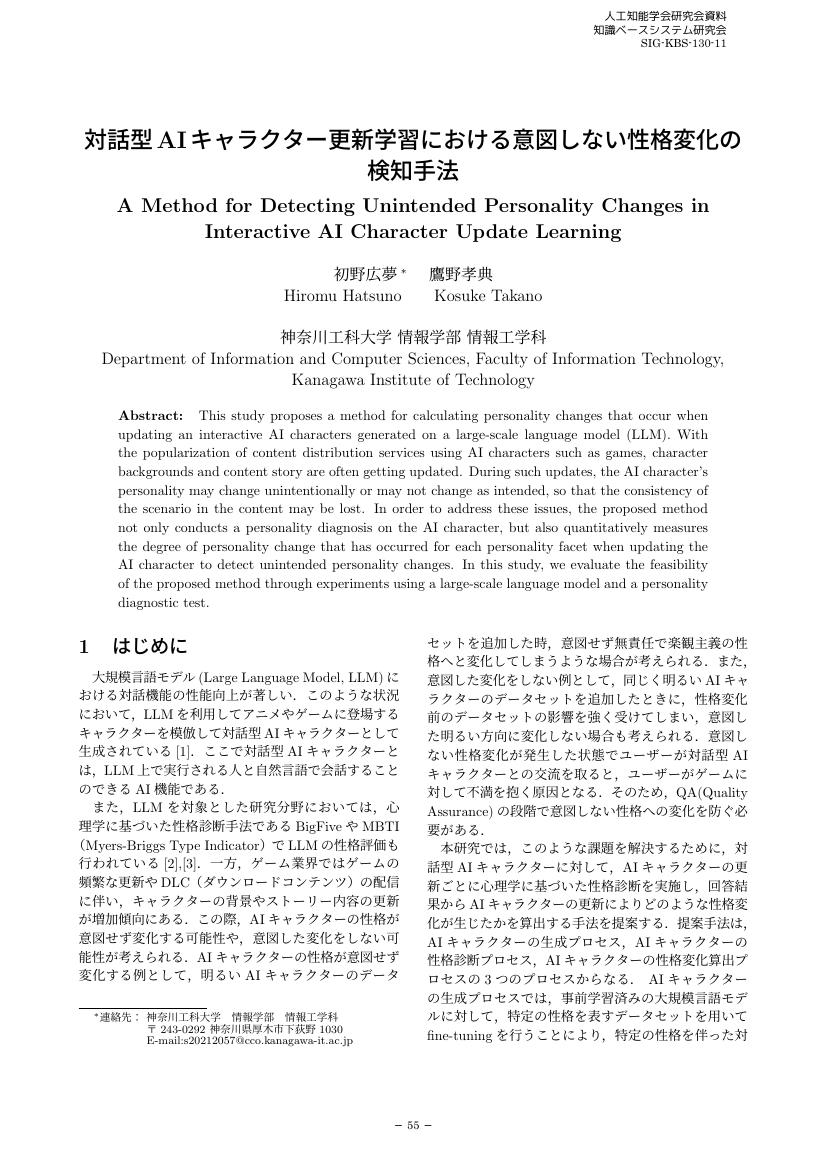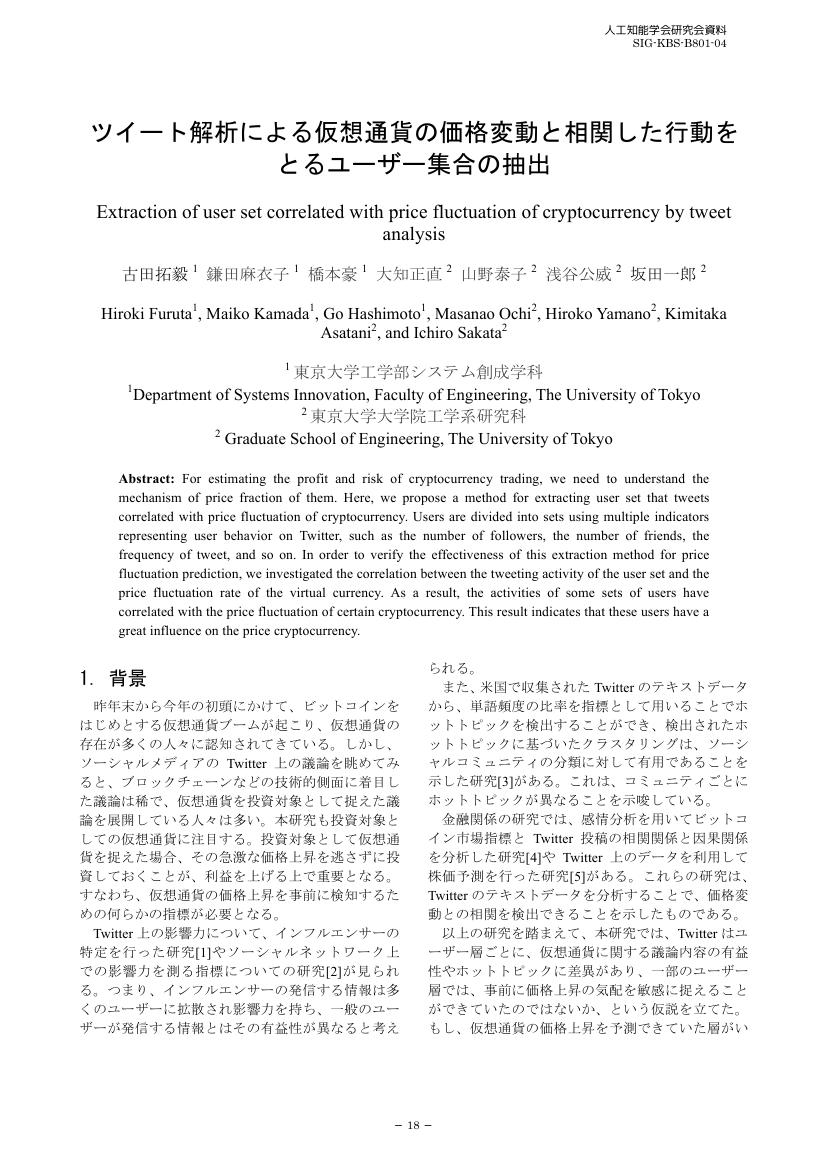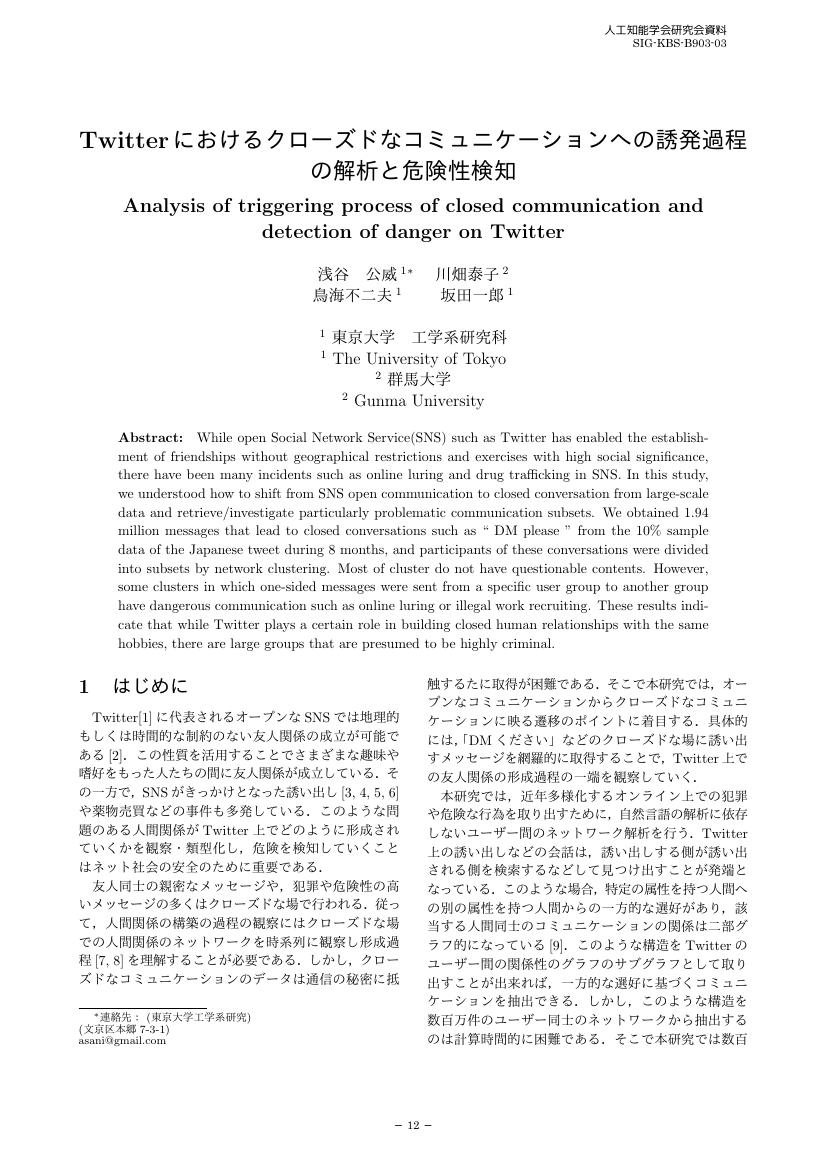- 著者
- 初野 広夢 鷹野 孝典
- 出版者
- 一般社団法人 人工知能学会
- 雑誌
- 人工知能学会研究会資料 知識ベースシステム研究会 130回(2023/11) (ISSN:24364592)
- 巻号頁・発行日
- pp.55-61, 2023-11-15 (Released:2023-11-15)
2 0 0 0 OA 動画サイトにおける視聴者コメントの特徴抽出
- 著者
- 堺 雄之介 伊東 栄典
- 出版者
- 一般社団法人 人工知能学会
- 雑誌
- 人工知能学会研究会資料 知識ベースシステム研究会 124回 (2021/11) (ISSN:24364592)
- 巻号頁・発行日
- pp.17-22, 2021 (Released:2021-11-15)
2 0 0 0 OA ツイート解析による仮想通貨の価格変動と相関した行動をとるユーザー集合の抽出
- 著者
- 古田 拓毅 鎌田 麻衣子 橋本 豪 大知 正直 山野 泰子 浅谷 公威 坂田 一郎
- 出版者
- 一般社団法人 人工知能学会
- 雑誌
- 人工知能学会研究会資料 知識ベースシステム研究会 114回 (2018/8) (ISSN:24364592)
- 巻号頁・発行日
- pp.04, 2018-08-01 (Released:2021-07-14)
2 0 0 0 OA Twitter におけるクローズドなコミュニケーションへの誘発過程の解析と危険性検知
- 著者
- 浅谷 公威 川畑 泰子 鳥海 不二夫 坂田 一郎
- 出版者
- 一般社団法人 人工知能学会
- 雑誌
- 人工知能学会研究会資料 知識ベースシステム研究会 119回 (2020/3) (ISSN:24364592)
- 巻号頁・発行日
- pp.03, 2020-03-01 (Released:2021-06-09)
2 0 0 0 OA 人工衛星の夜間光画像を用いた製造業の業種別の生産活動分析
- 著者
- 水門 善之 福馬 智生
- 出版者
- 一般社団法人 人工知能学会
- 雑誌
- 人工知能学会研究会資料 知識ベースシステム研究会 117回 (2019/8) (ISSN:24364592)
- 巻号頁・発行日
- pp.05, 2019-08-01 (Released:2021-07-14)
2 0 0 0 OA 外国人名変換システムにおける最適な漢字選択に向けた一考察
- 著者
- 坂口 琢哉
- 出版者
- 一般社団法人 人工知能学会
- 雑誌
- 人工知能学会研究会資料 知識ベースシステム研究会 109回 (2016/11) (ISSN:24364592)
- 巻号頁・発行日
- pp.08, 2016-11-01 (Released:2021-07-14)
2 0 0 0 OA 戦略の不確実性を考慮したカーリングAIの開発
- 著者
- 加藤 修 飯塚 博幸 山本 雅人
- 出版者
- 一般社団法人 人工知能学会
- 雑誌
- 人工知能学会研究会資料 知識ベースシステム研究会 104回 (2015/3) (ISSN:24364592)
- 巻号頁・発行日
- pp.02, 2015-02-26 (Released:2021-07-14)
Curling is a sport in which players slide stones on a sheet of ice towards a target area which is segmented into four concentric circles. Digital Curling can simulate the trajectory of the stones and calculate the resultant states after the delivery, so it can be used for supporting the tactics of curling. Different from the conventional testbed for artificial intelligence (AI), the game of Digital Curling require the software to consider the stochastic consequences. In this paper we propose the method to provide better tness estimation with less number of internal physical simulations for a player. The proposed estimation method to find the next move, is embedded to the AI program. By using the several simulation results, the effectiveness of the proposed method is discussed.
2 0 0 0 琉球諸語発音からの発見
- 著者
- 岡崎 威生
- 出版者
- 一般社団法人 人工知能学会
- 雑誌
- 人工知能学会研究会資料 知識ベースシステム研究会 123回 (2021/8) (ISSN:24364592)
- 巻号頁・発行日
- pp.08, 2021-08-20 (Released:2021-08-20)
- 著者
- 大西 悠平 猪口 明博
- 出版者
- 一般社団法人 人工知能学会
- 雑誌
- 人工知能学会研究会資料 知識ベースシステム研究会 124回 (2021/11) (ISSN:24364592)
- 巻号頁・発行日
- pp.40-46, 2021 (Released:2021-11-15)
1 0 0 0 OA ヒトの知能構築メカニズムならびに ネットワークのデジタル通信モデル
- 著者
- 得丸 公明
- 出版者
- 一般社団法人 人工知能学会
- 雑誌
- 人工知能学会研究会資料 知識ベースシステム研究会 89回 (2010/3) (ISSN:24364592)
- 巻号頁・発行日
- pp.10, 2010-03-29 (Released:2021-07-14)
ヒトの言語はデジタル通信である。そこでは、誤り訂正が行なわれて、情報源・通信路・伝送路の符号化が行なわれている。人間の知能は、(1a) 五官による記憶、(1b) コトバの記憶、(2) 大脳皮質上の神経結合による知覚記憶と言語記憶のネットワーク、(3) 概念体系を構築し、概念を操作する論理装置(回路)から成り立っている。\n
1 0 0 0 深層生成モデルを用いた衣服画像の印象に基づく操作に関する研究
- 著者
- 竹田 悠哉 横山 想一郎 山下 倫央 川村 秀憲
- 出版者
- 一般社団法人 人工知能学会
- 雑誌
- 人工知能学会研究会資料 知識ベースシステム研究会 128回(2023/03) (ISSN:24364592)
- 巻号頁・発行日
- pp.07-14, 2023-03-03 (Released:2023-03-03)
1 0 0 0 OA マルチレベル選択モデルにおける集団の分裂条件の変化による影響
- 著者
- 米納 弘渡 秋山 英三
- 出版者
- 一般社団法人 人工知能学会
- 雑誌
- 人工知能学会研究会資料 知識ベースシステム研究会 89回 (2010/3) (ISSN:24364592)
- 巻号頁・発行日
- pp.03, 2010-03-29 (Released:2021-07-14)
人間社会においては、互いに一度しか付き合うことのない非血縁者間でも協力行動が見られる。しかし、社会全体のことを考慮せずに自分のためだけを考えれば、協力しない方が常に得であるのも事実である。そしてそのように考えるならば、利己的な個人にとっては、自発的に他者に協力行動を取るべき理由は存在しないはずである。このような協力行動の進化を説明するために、これまで多くの人々が「集団間での闘争・淘汰では、集団の中に協力的な個体がより多い集団の方が生き残りやすい。」と主張してきた。しかし人類の場合、それに加え、その人を取り巻く人々や社会、文化によっても大きな影響を受けている。そのような文化的な慣習・制度の一部(単婚性や食料資源の共有)は、集団内での淘汰のメカニズムの効果を弱め、協力行動の進化を促進させる可能性がある。本研究はこのような考えの先行研究に基づき、集団構造を持ったエージェントシミュレーションを行う。そしてその結果を用いて、「人類社会で、どのような条件で協力が進化しうるか」を調査する。\n
1 0 0 0 OA Twitter のリンクベースでの会話コミュニティ抽出とコミュニティ内の単語使用特性分析
- 著者
- 丸井 淳己 則 のぞみ 榊 剛史 森 純一郎
- 出版者
- 一般社団法人 人工知能学会
- 雑誌
- 人工知能学会研究会資料 知識ベースシステム研究会 102回 (2014/7) (ISSN:24364592)
- 巻号頁・発行日
- pp.10, 2014-07-24 (Released:2021-07-14)
It is now common to have a conversation with others on social media. Many research have been taken to see the community structure on social media, but there are few studies that apply link-based community (link community) detection on a large social network. Link community detection allows users to belong to more than one community. We improve the method of existing link community detection of Ahn et al., which extracts many small communities. We evaluate existing and proposing methods by network indexes, and we characterize link communities from users' biographies. We found that link communities sharing users have similar characteristics from biographies.
1 0 0 0 OA 携帯電話GPS データを用いた経済活動分析と COVID-19 の影響分析
- 著者
- 水門 善之 柳井 都古杜
- 出版者
- 一般社団法人 人工知能学会
- 雑誌
- 人工知能学会研究会資料 知識ベースシステム研究会 120回 (2020/8) (ISSN:24364592)
- 巻号頁・発行日
- pp.01, 2020-08-20 (Released:2021-07-14)
- 著者
- 畑中 駿平 Wei Yang 細見 直希 翠 輝久 山田 健太郎 杉浦 孔明
- 出版者
- 一般社団法人 人工知能学会
- 雑誌
- 人工知能学会研究会資料 知識ベースシステム研究会 126回 (2022/08) (ISSN:24364592)
- 巻号頁・発行日
- pp.34-39, 2022-08-19 (Released:2022-08-19)
1 0 0 0 衛星観測データを用いたCO₂濃度の計測とマクロ経済活動の推計
- 著者
- 水門 善之 田邊 洋人 望月 悠理
- 出版者
- 一般社団法人 人工知能学会
- 雑誌
- 人工知能学会研究会資料 知識ベースシステム研究会 124回 (2021/11) (ISSN:24364592)
- 巻号頁・発行日
- pp.01-05, 2021 (Released:2021-11-15)
- 著者
- 太田 博三
- 出版者
- 一般社団法人 人工知能学会
- 雑誌
- 人工知能学会研究会資料 知識ベースシステム研究会 124回 (2021/11) (ISSN:24364592)
- 巻号頁・発行日
- pp.11-16, 2021 (Released:2021-11-15)








